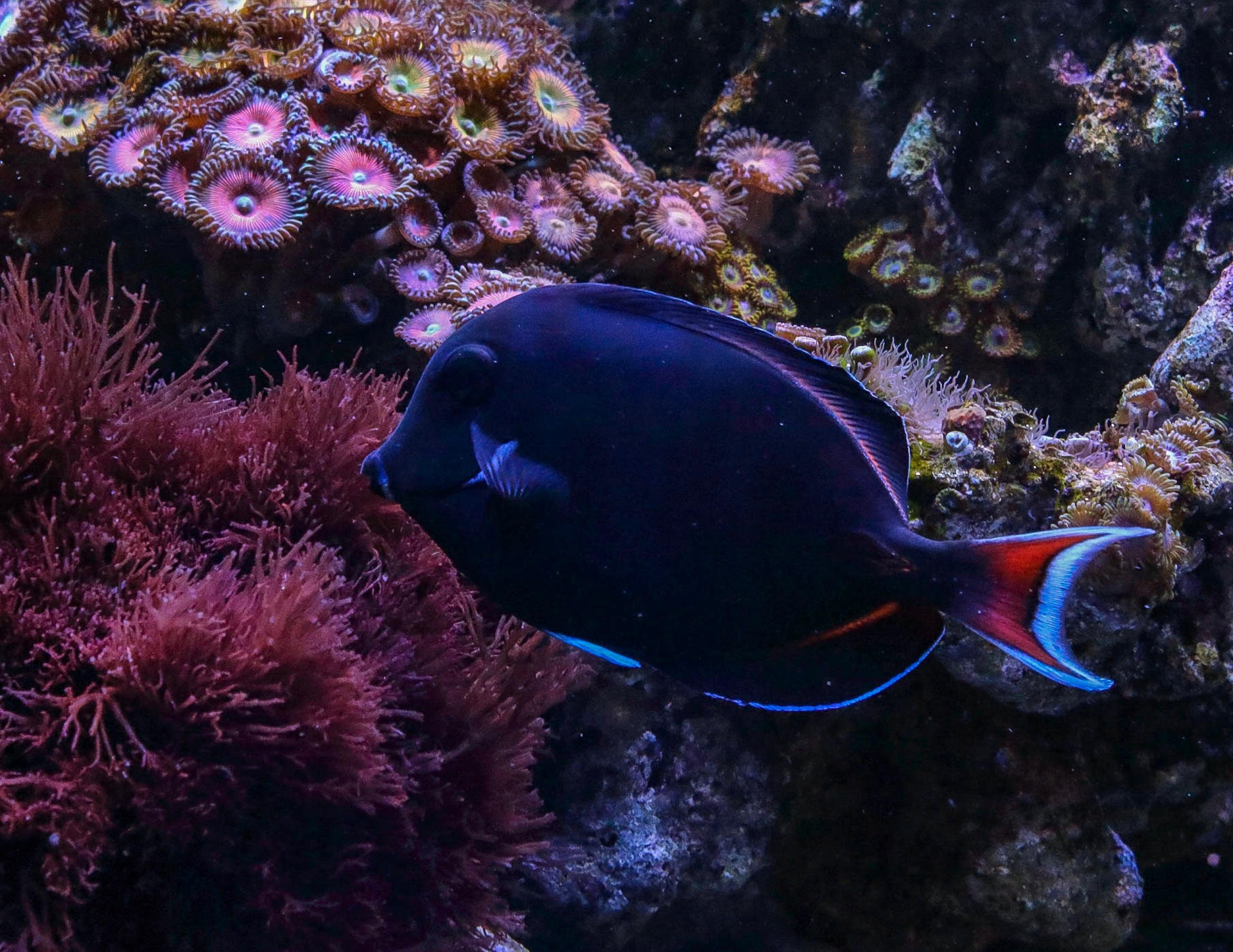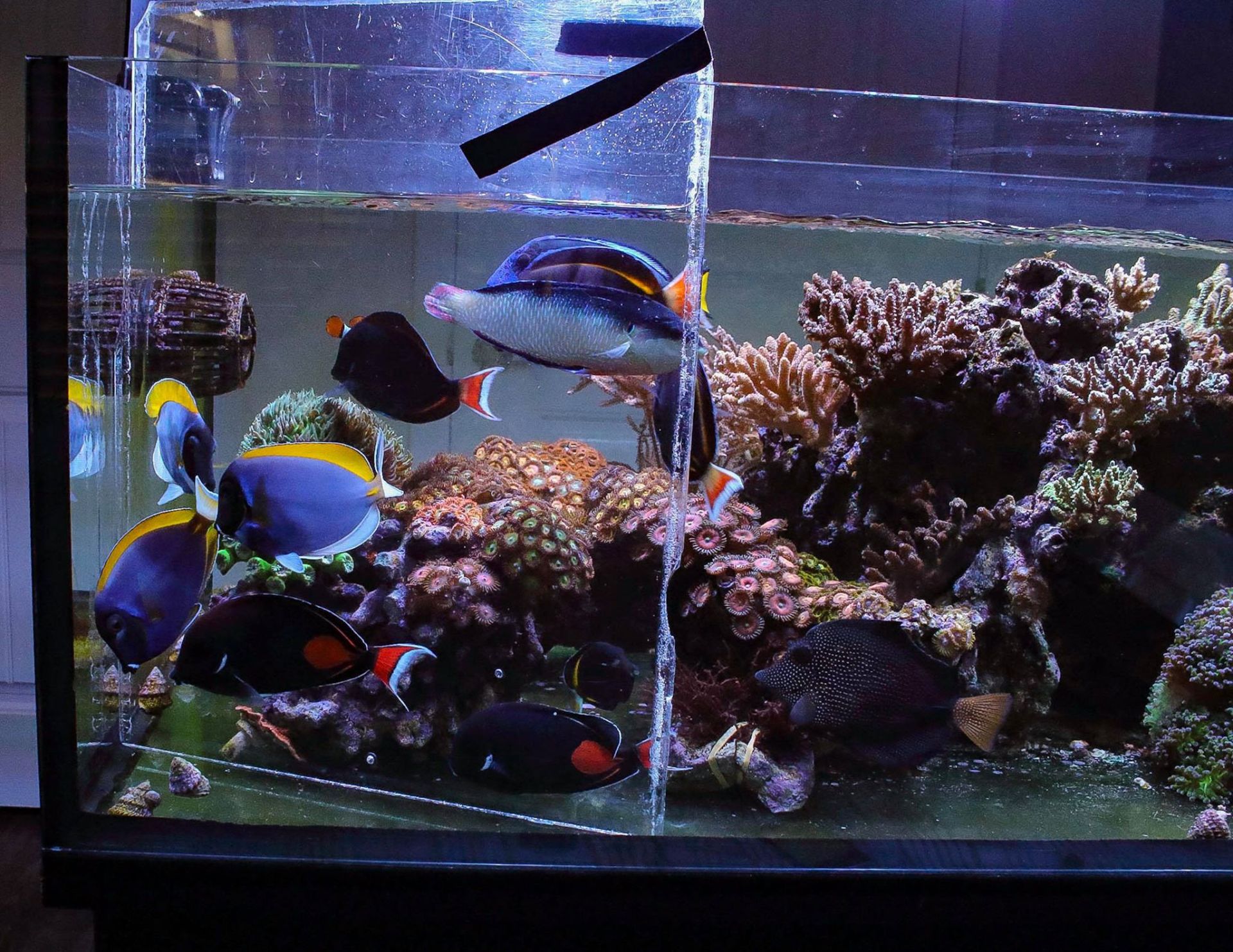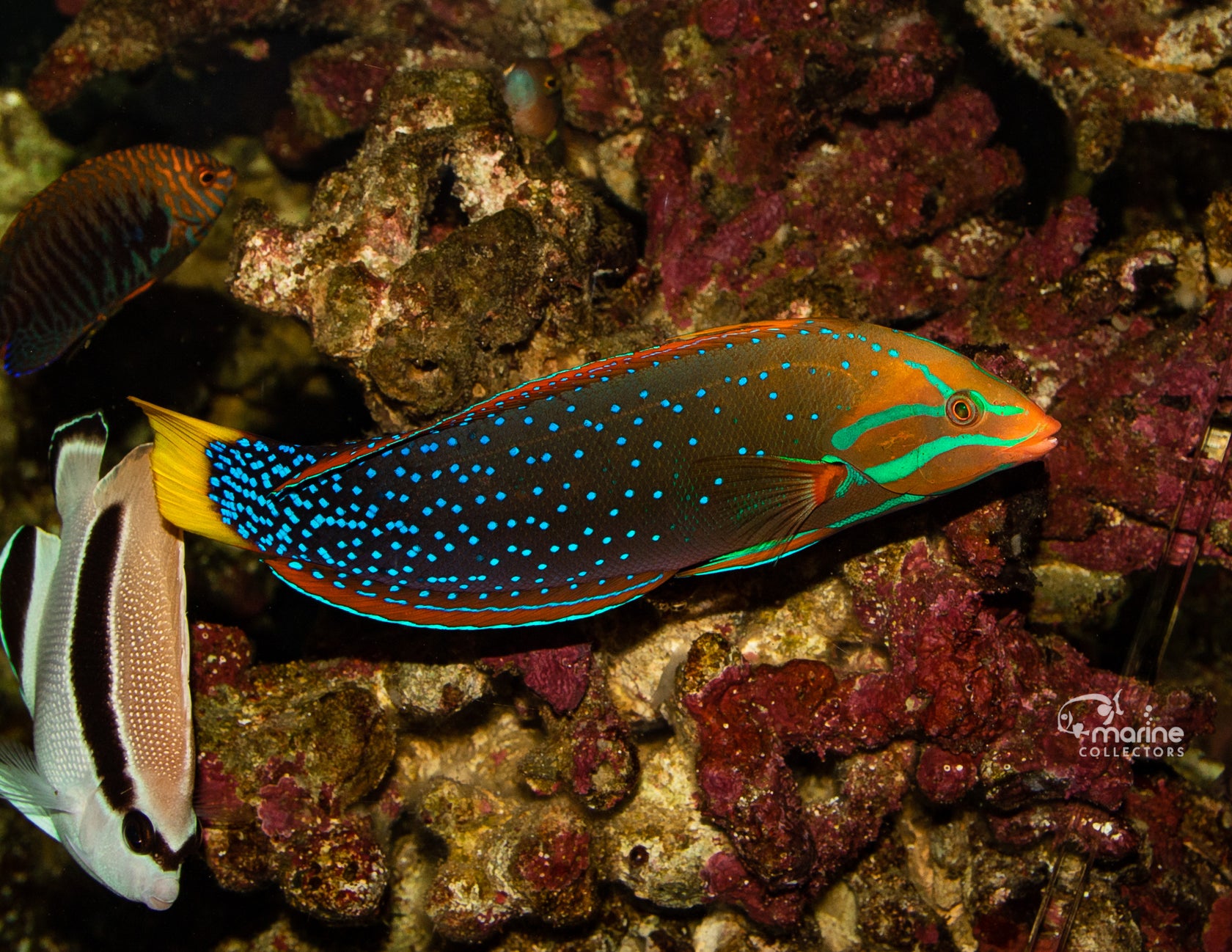
Intro:
Acanthurus, more specifically, Powder Browns, Powder Blues, Achilles, Goldrims, and all the hybrids in between; the fish that everyone labels “ich magnets” or “impossible to keep”! These are the fish believe it or not, that got Marine Collectors Started started and our specialty that we have become known for.
1. An Aquarists’ Mindset:
Ok so why Acanthurus? It’s a group of fish that most people fail to keep. Anytime the opportunity presents itself, I always ask why? And everyone always has the same string of excuses: it’s to risky, they always get crypt(cryptocaryons irritans or “ich”), they are aggressive, they need big tanks, etc. But what fun is the hobby if you have limitations on the fish you can keep based off of perceived ability. So many people always tell me: “I’d love to have this fish, but I can’t”. There’s no excuse for not having what you want in this hobby; all limitations (excluding financial) are always driven by lack of effort or an understanding of why. The concept of “I’m a newbie therefore I can’t keep this fish or coral” is insane! The amount of time that you have been in the hobby does not equate to the amount of success you’re going to have. I know guys who have marine biology degrees and have been hobbyist for over 20 years and they have some of the worst tanks I’ve ever seen!!! Success in the hobby is about knowledge and understanding why things work the way they do. If you’re a newbie who’s been in the hobby less than a month but has been taught all the right information, there’s no reason that you can’t be even more successful then some who have been in the hobby for decades. This is why it’s always important to ask WHY! Learn from others mistakes and experiences; understand the science and the biology that’s going on in our aquariums. I promise you, it will only lead to greater success sooner!
2. Acanthurus:
So up front, I’m going to cater to the tang police and say that I don’t particularly recommend putting fish like this in small tanks, but if you are diehard enough and just have to keep one, there are ways around it. Tangs in the wild can swim miles a day and no tank regardless of the size is really ever going to compare to the ocean, so how can we mimic the fundamentals that it offers? If the tank is smaller then crank up the flow. Fish need exercise! They need to make up for not swimming miles a day. There was a study done on why old aquarium fish die, and the majority were from excess body fat content. Yes, they were basically dying from obesity. Essentially by increasing flow you are creating a treadmill type environment so the fish can swim and burn up calories and energy. Weird to think of fish in that way but the fundamental process of caloric intake, energy, and fat storage is not so much different than humans. It’s finding the balance between energy in and energy out.
Now what about when they outgrow the tank? Unfortunately there’s no real way around that. Fish are going to grow, and that’s just something you have to accept. The important thing is to make a plan before purchasing. When the fish get too big, where’s it going to go? I always make it a matter of importance to figure this out before buying. After all, we are responsible for the well-being of the animals we keep at home. What I tell most people and what I do personally is to have a rotation. Start small, let them grow, pull them out, trade them in for smaller ones, and repeat. LFS are usually more than happy to take established fish and exchange them for smaller ones because everyone wants fish that have been in a tank for a while and are used to aquarium life. You should, however, be able to get a couple years out of them before having to dramatically upgrading.
3. Quarantine:
QUARANTINE!!!QUARANTINE!!!QUARANTINE!!! The thing that we all hear coming into the hobby but don’t take seriously until it’s too late. As someone who keeps a tank full of only sensitive fish, it’s a practice that I find everyone eventually gets to. Even if you plan on never keeping sensitive fish, why wouldn’t you quarantine anyway? There’s no such thing as 100% disease or parasite immune fish. Saltwater fish aren’t cheap! So what would it hurt to have the extra assurance? Absolutely nothing, just a little extra time. Ideally you would quarantine from the get go and give yourself a sterile display to start with. But if you’ve never quarantined all hope isn’t lost; quarantine is proactive outbreak prevention. It’s never to late to start.
When quarantining Acanthurus there are a couple ways to do this and one major thing to look out for.
Medicated-
Run a combination of medications. In my systems, I run copper(coppersafe), nitrofurazone, and praziquantel at the same time. And yes they can be run together, the fish will be fine. Copper is a gill irritant, and is the only medication that may affect a fish’s behavior(such as not eating). But generally with Acanthurus there isn’t this issue. When using chelated copper sulfate(coppersafe) use an API test kit; though all of their other saltwater test kits are super inaccurate, it is the most accurate for chelated copper sulfate. Nitrofurazone will help combat any bacterial infections, and prazi will take care of any external parasites such as flukes. If you want to be more proactive about it, you can give the fish a freshwater dip for 3-5 minutes mixed with prazi. If there are flukes on the fish you should be able to see them turn white around the 30-40 second mark. It’s important to also turkey baste them off the body of the fish so you don’t introduce them into the quarantine tank. Quick tip** when dipping fish, make a transition dip of half salt and half fresh for the fish to go into after the freshwater dip. Saltwater fish have no problem dropping salinity, but going back up is extremely harsh on their body so having an in between dip will help them to recover with less stress. While in the quarantine, observation is your best friend. Every day you should check the fish in the morning and at night. Typically I like to take a flashlight to the fish at night and look for any developments. Such as crypt, velvet, or flukes. If something were to appear, it is usually within the first 8 days.
Here are the levels that I have found work best:
- Coppersafe running level : 2ppm
- Praziquantel running level: 5ml per 20 gallons
- Nitrofurazone: 1/2 tsp per 25 gallons
- Freshwater dip w/ prazi: 1ml prazi/ gallon
Depending on your style of quarantine set up, you may do water changes. Always prep the new water with the medications at the right levels prior to doing a water change. This does two things: one keeps all levels constant so any parasites or disease don’t give them a chance to take hold and second you don’t shock your fish. Anytime you dump meds into the water column there’s always going to be areas of higher concentration where the fish can be affected. For example let’s say you dose copper into the quarantine tank and your fish swims into the cloud of copper. Guess what? That fish’s gill filaments are fried and it’s going to have trouble absorbing oxygen from the water.
Quick tip** always test copper levels of new mixed water prior to adding nitrofurazone. Copper is a color test and nitrofurazone will add a yellow color to the water that will make it impossible to read the rest.
Acanthurus are a high energy fish and consume a lot of oxygen, protein skimmers, air stones, and extra flow are always helpful too.
For those who want to know how to set up a basic quarantine, this article is for you:
https://www.reef2reef.com/threads/how-to-quarantine.189815/
One major thing to look out for with tangs in general is copper poisoning. Unfortunately in recent years I’ve seen more and more of this, and most of the time it comes from overseas. It’s almost always caused by collectors (the people actually catching the fish) holding fish in high concentrations of copper treated water awaiting ship out. If you’ve ever had a perfectly healthy tang in quarantine, eating, behaving normally, and going great then suddenly dies out of the blue this is likely the cause. Unfortunately there’s no real way to catch it once you have the fish. If you do see the fish suddenly have a seizure like occurrence, put it in unmedicated water immediately, and move water over the gills. They usually come back and start behaving normally again. Unfortunately this is when you can no longer use medications on this particular fish and they need to be treated without meds. Such as with TTM. Vendors out there, if you’ve noticed this with some of your fish, I strongly urge you to find a new supplier.
TTM (tank transfer method)-
I’ve actually really come to like this method especially for fish sensitive to meds, because it is a way to not run any types of harsh medications. The principal is to basically outrun the parasites lifecycle by moving the fish every few days to a new tank before the parasite has time to reproduce and re-attack the fish. This method, however, doesn’t work on every form of parasite. Velvet is one example of this. In order for it to be successful on rapid replication parasites you would have to move the fish almost every 12 hours. Not impossible to do, but incredibly labor intensive, and requires 3-4 tanks.
Quick tip**: For my fellow vendors out there who have oxygen tanks, you can do this with bags and repack fish every 12-24 hours with 100% new water and new bags! Works great!
Quick tip**: between transfers you can put the fish in a freshwater dip to essentially “rinse” off any water/ free swimming stages of parasites from the previous tank.
For an in depth instruction on TTM:
https://www.reef2reef.com/…/spars-tank-transfer-method.209…/
For those of you who who might be wondering, if you wanted to be extra cautious, you can even run TTM with meds for a more thorough quarantine.

4.Diet:
Tangs are herbivores which mean that they need more than just Mysis and pellets. They need algae, a variety of nori or live ogo is what I generally feed. If you have access to it at a LFS or order it from me, ogo(gracilaria pacifica) is a great live food to feed tangs! The added benefit of feeding live algae is its cleaner and doesn’t make excess waste in the aquarium. It’s also a food that you can have in the tank 24/7 that fish can graze on as they please, and it’s not going to rot after a certain amount of time like nori will.
5. Mixing Acanthurus and tangs in general:
Alright now for the thing I get asked about the most. How do I keep so many sensitive and aggressive tangs all in the same tank without issues? The answer is actually very simple, all aggressive fish are aggressive for one reason only; scarcity. Scarcity of food, mates, and the territory that joins the two. But if we get rid of this then there’s no reason for any more issues. Tangs in general like having a sense of no competition. There are two ways we can take this. The first is by having a tank of such massive proportions that there is enough territory that everyone keeps to themselves. But the second and more applicable way is through over abundance of food and eventually overcrowding.
So above I mentioned that I feed Ogo, I keep 3 rocks with bundles of ogo throughout the tank at all times. When it runs out I make sure to replace it. And for the most part that is all I feed, occasionally I’ll supplement some nori or spirilina brine or Mysis but that’s maybe once a week. This way of feeding allows the fish for constant grazing 24/7 like they would have available in the ocean. For a fish to come from the ocean where it’s used to eating around the clock, to being put into a tank, where it’s only receiving food once or twice a day makes them increasingly more aggressive. Why? Because of scarcity, food only comes in limited quantities and fish learn that. So each time they get fed it’s more important to them to get as much for themselves as possible. It’s also why a lot of fish are always coming to the glass when they see us and always look hungry; they’ve been trained that we are the source for food and it’s only there for them when we come around. My tangs almost never come up to the glass anymore because there’s no direct association with every feeding response that I’m what’s providing the food. They eat hundreds of times a week and I only provide it maybe 3 of those times when I put more ogo in. Food to them, is always there, and in abundance and this reduces aggression. However, most fish have to be trained to reduce aggression. They have to learn that they don’t need to compete for food. Generally in my experience this takes anywhere from 3-14 days. This is what I call the break in period, where aggression and some fighting is completely normal.
So earlier I mentioned overcrowding. If any of you have ever kept African cichlids community tanks, you’ll be familiar with the concept. Essentially the concept is to put so many aggressive fish in a confined space that none can ever establish a territory and keeps aggression down because no one fish will be able to occupy a set space as the number of individuals is to high. Now you might be thinking that that’s not fair to over crowd the fish, but something we have to remember is that in the ocean a single Acanthurus can occupy hundreds of square feet of territory. Very few of us have tanks that can even compete with that, so the concept of overcrowding is really just for the fish’s perception of below normal in territory standards. Something you will however notice is a hierarchy will develop of dominant and sub dominant fish not over territory, but over social behavior.


So what about when I’m adding more Acanthurus to my existing ones?(see photos to the right) The trick I’ve found best is to always match sizes as closely as possible, keep odd numbers(when in the range of 1-5), let them get used to each other and also isolating established fish. What does this look like? When I’m adding more fish out of quarantine, I put them behind some acrylic for about a week or two; letting the established fish view and interact with them without contact. This also allows them to break in a bit too. Fish don’t always need to nip fins or chase each other to establish dominance; they can do it though sight alone. After about a week, I’ll then catch the most dominant established fish and isolate them behind the acrylic while I let the new ones into the display. What this does is give the new fish a chance to get a feel for the tank and the aquascape and interact with the sub dominant fish and find out where they integrate in the hierarchy. After about 3 days behind the acrylic I’ll let the dominant fish back out and let them all feel each other out. Generally there’s a little fighting between select individuals, but not always, fights usually never last past a day. And that’s about it. Hope this helps anyone trying to keep this genus for themselves!
Thanks for reading, Happy Reefing!!!


